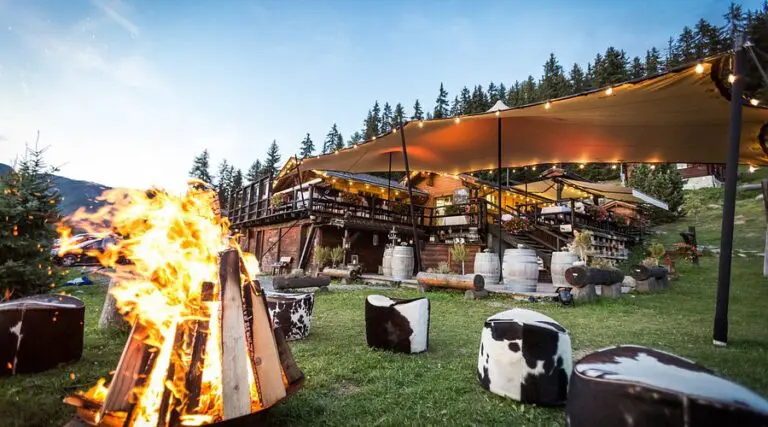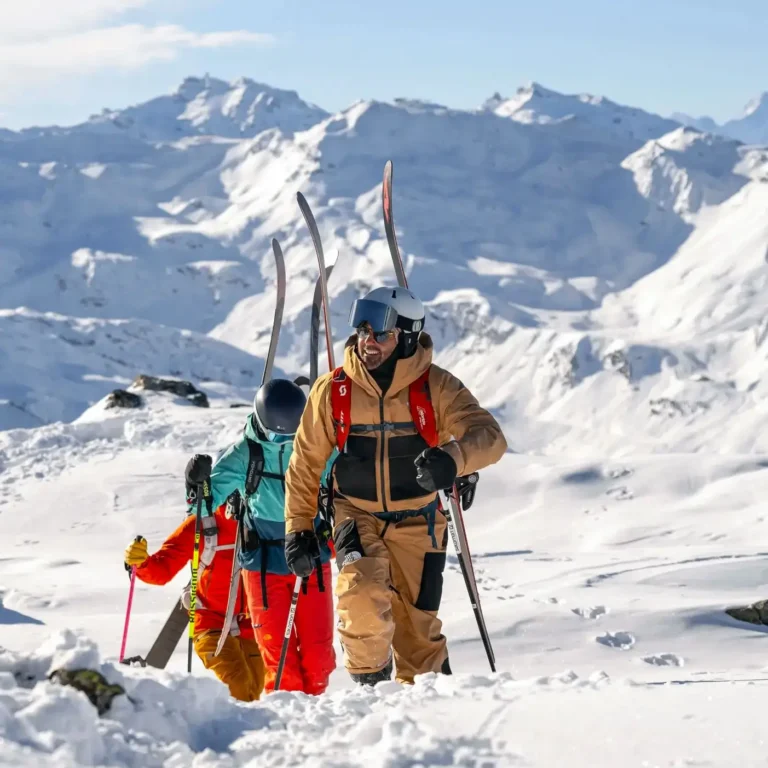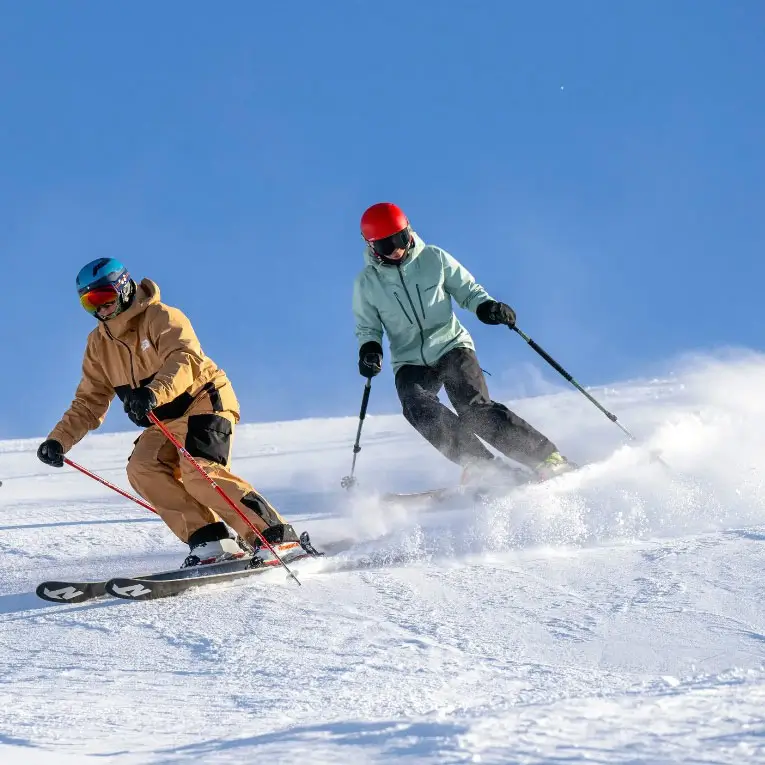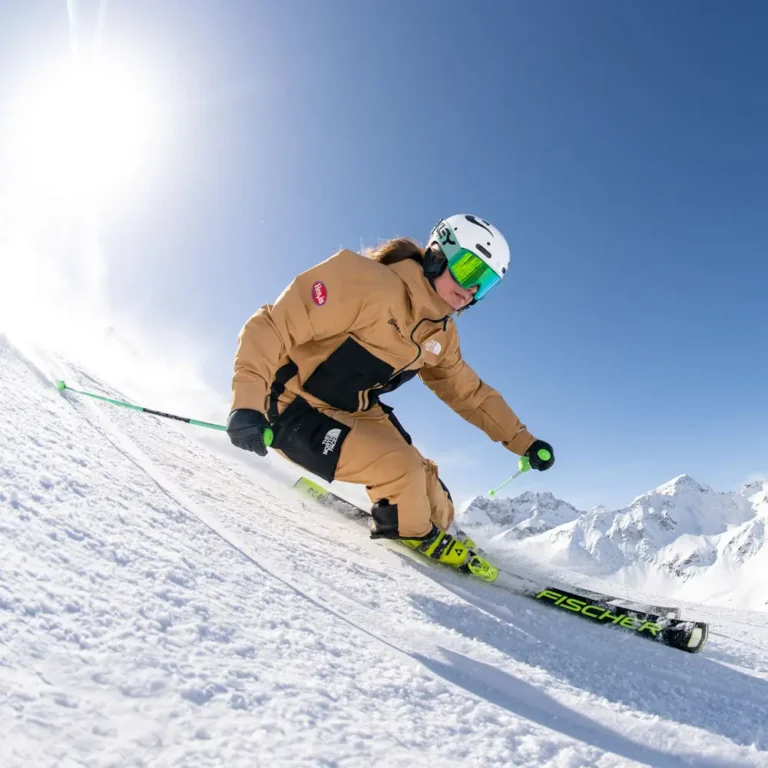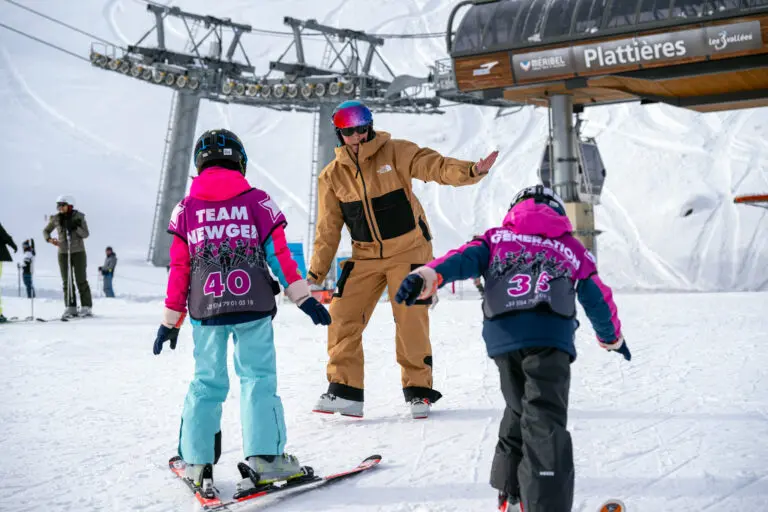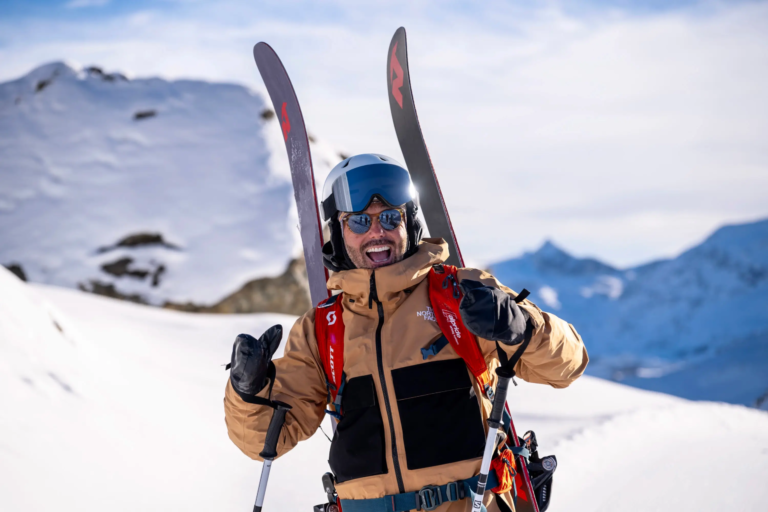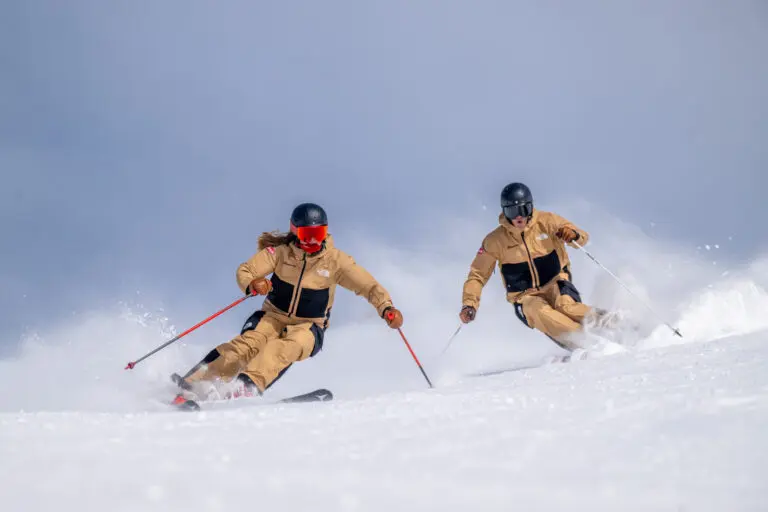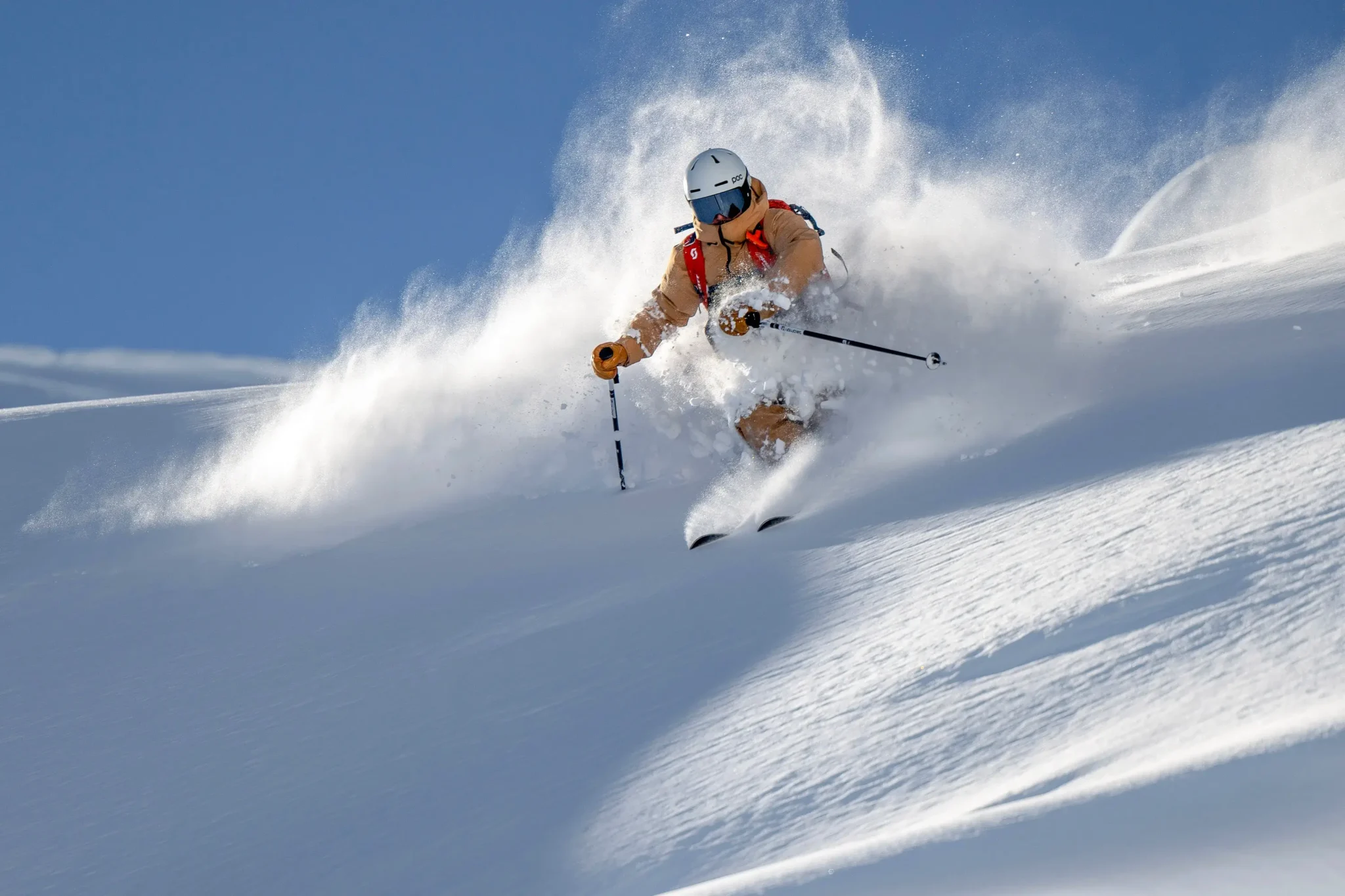Moguls add a lot of fun and variety to skiing. Every line you ski varies and forces you to be dynamic to stay locked in a line. Yet even avid skiers avoid them. If that is you, our guide on How to Ski moguls will encourage you to give them a second chance.
Every mogul field is a puzzle to be solved. You must turn when the moguls tell you to, not necessarily when you feel comfortable. It’s like tree skiing or ski racing. You’ve got to turn around the tree or gates to succeed. You can’t just ski where you like—so to say!
Many people find this tricky, as skiing moguls require a lot of focus and athleticism. Knowing how to pick the best line through them and how to perform the vital technical movements is crucial if you want to succeed. In this article, we explain how to ski moguls.
HOW TO SKI MOGULS
What are Moguls?
Firstly, what are moguls? If you’ve never heard of the skiing term ‘moguls’ before, you may know them as ‘bumps’. Moguls or bumps are undulations in the snow that many people find tricky to navigate while skiing. Some moguls form naturally, and others are purpose-built.
Skiing moguls is an art and requires the right amount of technique, discipline and fitness to ski them with style. Some of the best mogul skiers have impeccable timing, balancing the right amount of flexion and extension as they rise and fall down the slope.
They’re decisive when picking a line at the start of the run and stay focused on it, never faltering or showing that they’re out of control. It takes discipline, strength, and dynamism to remain calm and reset even after a little wobble.
Getting started: Mogul Skiing tips.
Warm-up.
Your knees will need to be ready! So, we’d recommend doing a couple of laps on the groomed slopes to get your body ready, as skiing moguls can be quite physically demanding.
We’d recommend playing around on the spine on the side of the piste (where the groomed and un-groomed edges meet). Practice skiing short turns, but start slowly and push the snow away from your feet, getting used to the feeling of steering your feet over the ridge and back again.
It’s helpful to practice skiing in various conditions, and it’s crucial to take note of the snow, as it’s often softer in the afternoons, especially in the springtime. So, planning to ski bumps in the afternoon is always a wise idea, as it will be more forgiving on your body, and the softer snow will make speed control far more manageable. Nobody likes icy bumps first thing in the morning!
Pick a line and visualise it.
To decode the bumps, you need to make a plan of attack by picking the best line possible through the moguls. Advanced skiers aim to select a line straight down the fall line, from top to bottom of the mogul fields. A fall line descent doesn’t mean you ski straight down without turning. The fall line is a theoretical straight line between where you are and the bottom of the slope. When following a fall-line descent, stay as close to this as possible.
There’s no right or wrong line to pick. That’s the beauty of skiing moguls. Different lines and tactics can be used to ski the bumps. Watching someone ski moguls with flair and style is more entertaining than being too rigid or robotic.
When starting, aim to keep your skis in contact with the snow. You’ll need to use your legs like suspension, flexing and extending constantly. A great way to practise this and warm up further is to traverse a bump run. You won’t have to worry as much about speed control as you’re not skiing in the fall line, but you can still practise some of the movements required.
When starting, look for a line where the moguls are consistent and manageable. Regarding line choice, it’s best to start easy and work your way up to the larger bumps. Scan your eyes to the edges of the mogul field as often as possible, as there are more minor bumps on the sides. Look for evenly-spaced moguls. They will help you stay in rhythm and build confidence as you pick up the pace.
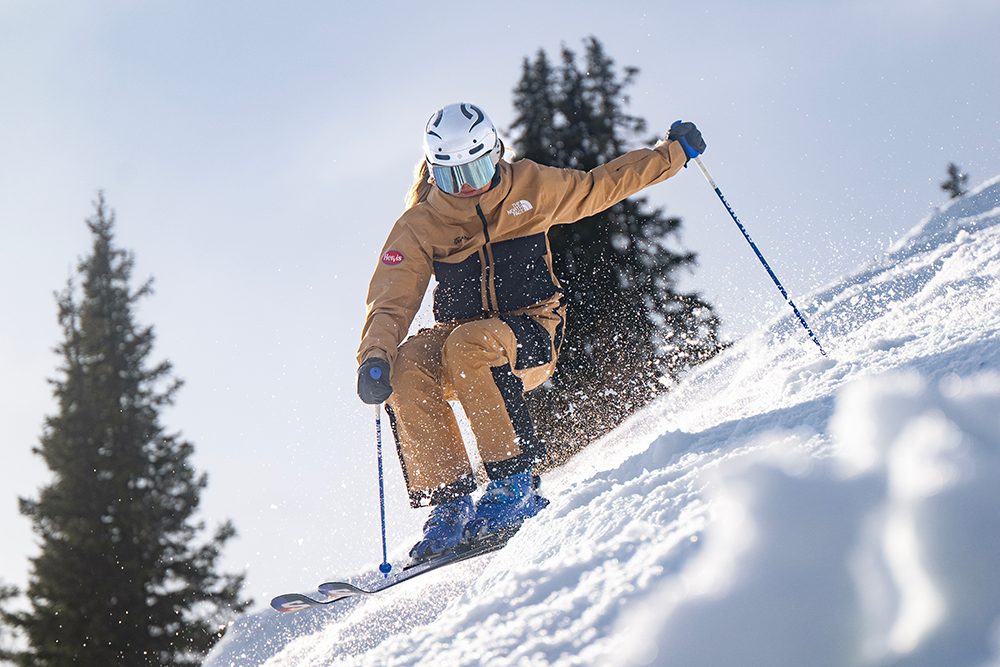
Speed control and Turn Shape.
How quickly you travel is directly linked to the tactics or lines you decide to use. There are three main tactics or lines when skiing bumps. We’ll start with the easiest and work up.
The Inside or Inside wall line
This approach provides the most accessible opportunity to control your speed when starting. The aim is to turn on the highest point of each bump and then slide down the far or back side of it. It is like a never-ending series of hockey stops, but instead of bringing yourself to a complete halt, maintain a little momentum to start that next turn.
The Outside Line
When skiing the outside line, your skis will move out and back towards the body in a much wider arc. Rather than sliding down the back of the mogul, your skis follow the camber on the outside of the rut, a little like skiing or riding a berm. Skiing bumps this way often looks fluid and graceful. However, you’ll travel faster. Speed is controlled using a combination of a rounder turn shape and some skidding.
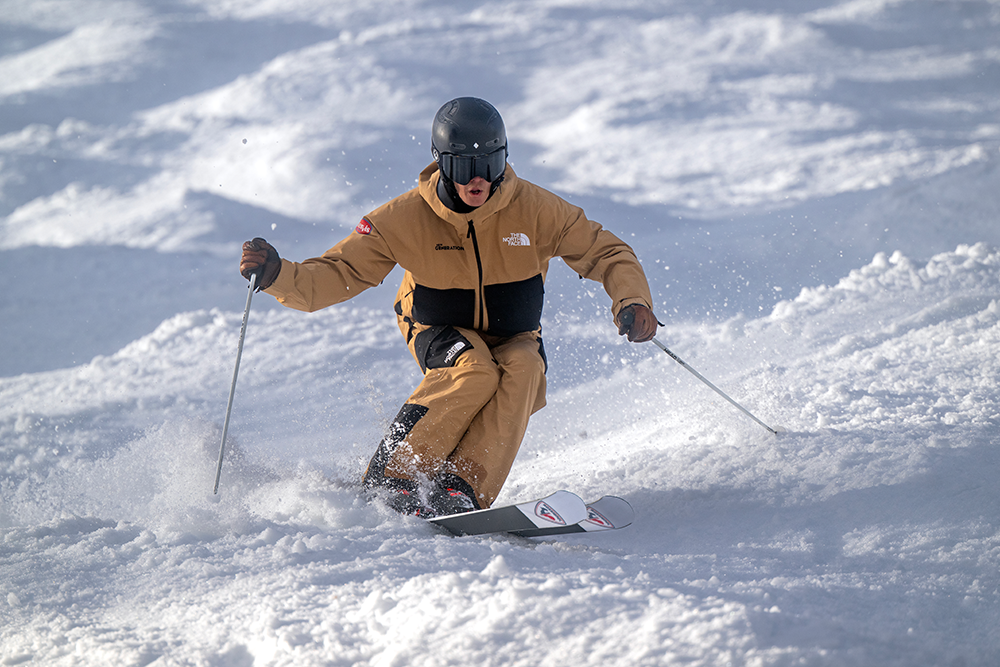
The Direct line
The most direct line is the fastest way to ski moguls and the approach taken by Olympic skiers. It is complex and physically demanding. When skiing the direct line, your skis will spend far more time following the fall line. While they will deflect across the slope to match the terrain, they will almost certainly never get close to being perpendicular to the fall line.
The primary method of speed control for the direct line is pressure. As you hit the face of each bump, you flex your ankles, knees and hips to absorb the impact, then use the remaining momentum to initiate the next turn. Most skiers will check a little using a skid on the face of each bump, but there is very little time, and your body is already dealing with lots of forces. It’s like running into a wall whenever you want to slow down and change direction. This line requires the most practice but is great fun.
Our top tip is to constantly look ahead to the next turn. When you’re in the middle of the trough, look downhill to choose your next control point before the next turn, and repeat!
The first couple of times you ski through the bumps, you’ll notice your skis are often across the hill. But once you’ve had a go skiing the same line a few times, try and get your skis straighter, facing down the mountain, one turn at a time.
You’ll probably feel uncomfortable again, but break the mogul field into sections and challenge yourself to five turns like this. You’ll soon figure out your optimum speed to feel confident while challenging yourself! Mogul skiing is all about the perfect blend of edging and steering.
Ready to Tackle the bumps?
When it’s time to think about the technical aspects of mogul skiing, you need to accept that you’ll pick up speed as you’re facing down the fall line for longer.
Our top tip for the way you move through a bump run is to think about avoiding the holes or troughs in between the bumps. Imagine going around the edges or inside the wall of the bumps to keep a steady rhythm.
Specific Techniques to Practice: Skiing Moguls
One of the best pieces of advice this article offers is to be proactive instead of reactive when mogul skiing. By consciously and actively moving your body in anticipation of the moguls, you’ll remain in control and stay one step ahead!
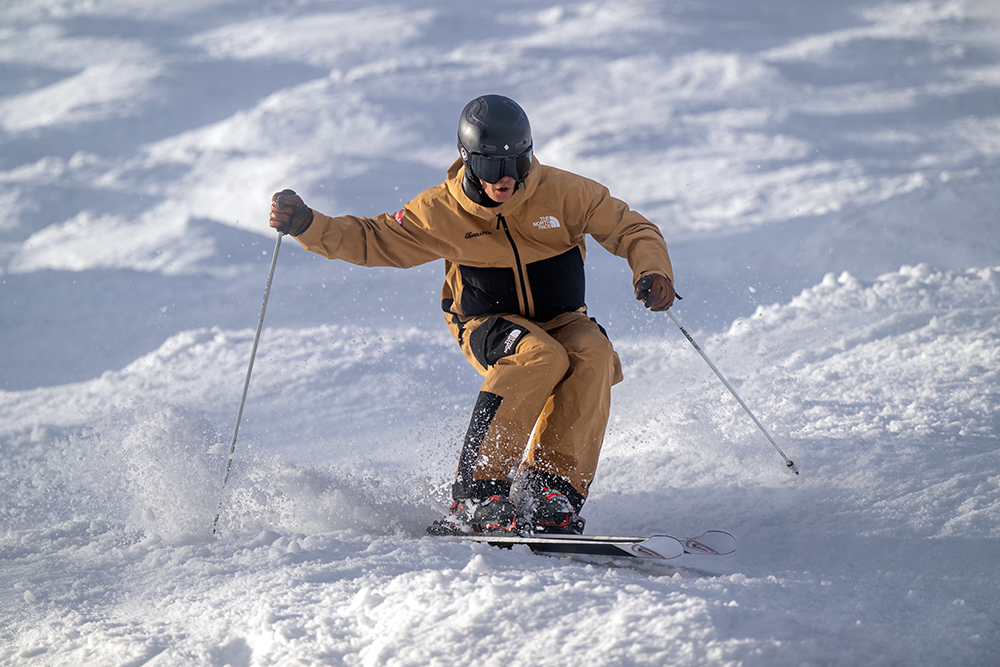
Moving up and down (flexion and extension)
It’s tricky to ski moguls if you remain rigid. Flexing and extending your entire body is essential to control the force the snow exerts on your body. Your centre of gravity needs to stay in a constant position down the hill without being thrown up and down when you’re in and out of the bumps.
To put it simply:
- You should be the smallest at the top of the bump
- You should be tallest at the bottom of the bump (in the trough)
Like a car with suspension on a bumpy road, you must elongate your lower body when in the troughs and suck your knees up to absorb the bumps when higher on the side walls. This also keeps your skis in contact with the snow, making your balance less likely to be disturbed.
It can be tricky to transition from a very tall stance to a tiny stance while remaining in sync with the terrain, but with a solid core and using the tips mentioned earlier to find control points, you’ll get there with a bit of practice.
Suck your feet up.
When you reach the seesaw moment on the backside of the bump, the tips of your skis aren’t touching the snow. Leaning forward to create tip pressure would help you initiate the next turn.
By sucking your feet back up underneath you, your skis are in contact with the snow longer, meaning you’re more likely to stay in control and perform consistent turns.
Sometimes, mogul skiing might feel like your body is ahead of your feet, but that’s normal! When you ski bumps, you’re facing down the fall line for longer, so you’ll feel like your body is accelerating forward whilst your feet are getting pushed back by the bumps.
When you’re on top of the bump, you may feel quite centred, and as you move into the new turn, start again by applying pressure to the front of the ski. Keep repeating this motion.
Pole Planting
Using your poles in the bumps allows you to improve your lateral stability and rhythm. Pole plant after the bump (on the backside of the mogul) instead of on top of the bump – so that you’re always reaching forward. Planting your pole on top of the mound may throw you off balance, too. So, be prepared and have a solid stance to help you prepare for the movements.
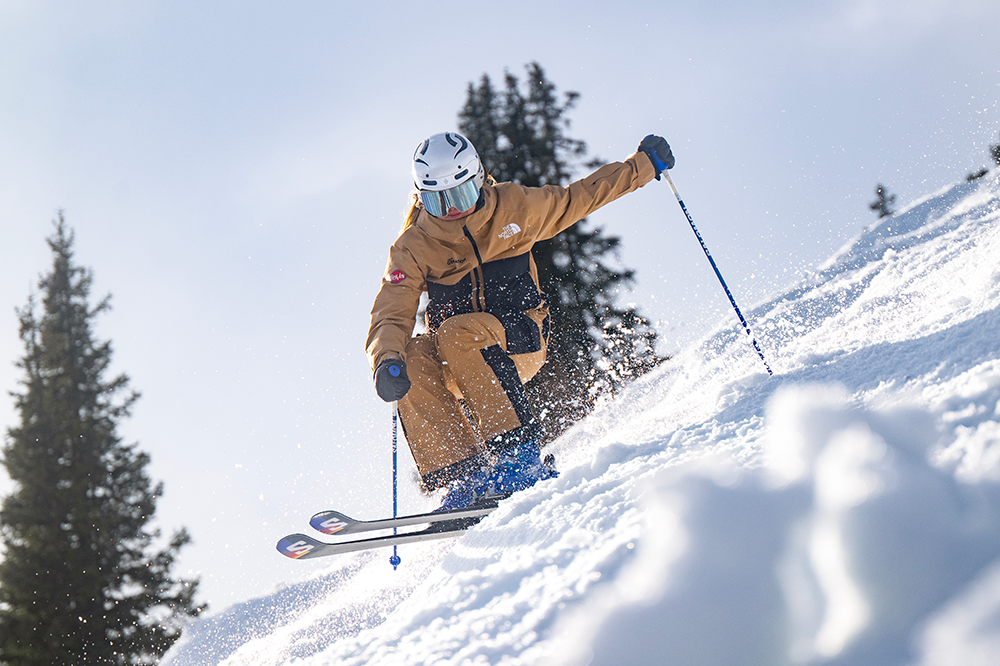
Top tips for pole planting when bump skiing:
- Pole plant at the end of the turn, not the beginning of the next one.
- Be ready to pole plant early (when you’re halfway through the previous turn)
- Be positive and decisive when planting your pole on the backside of the bump.
- Extend your arm out away from you, reaching forward.
A precise pole plant is essential when learning how to ski moguls. If you’re UK-based and want to practice skiing moguls, Chill Factore in Manchester has specific Moguls sessions in the snow dome. Find out more about Mogul skiing at Chill Factore.
Hockey stops
A hockey stop is when you over-steer slightly to come to a halt. This technique is valuable to impress your friends and quickly stop on the slopes. You can abruptly stop by creating an edge angle with your downhill ski. You’ll need to have all your weight on your downhill ski, and you’ll need to rotate your feet at the same time.
It helps to have your feet a little closer together (feel for the boots touching the inside of the ankle), and you’ll need an athletic stance to rotate your legs underneath your upper body. This same concept can be used in mogul skiing as you need to move your feet as one unit quickly and keep your upper body solid whilst your legs and feet do most of the work!
Learn how to do a hockey stop:
Ski Equipment
- Do you need shorter poles for bump skiing?
- Do you need shorter skis to ski bumps?
- Do I need to rent different skis?
Having shorter poles in the mogul field will help to stabilise your upper body. If your poles are too long, you’ll have even further to travel vertically from the deep flexed position. Typically, competitive mogul skiers use shorter poles than we use for everyday skiing.
These days, your rental skis will be excellent in the bumps. However, those competing in moguls tend to opt for narrower skis and more flexible boots. If your boots feel too stiff, you can experiment by loosening the top buckle around the calf.
Do you feel like you know how to ski moguls confidently?
If you’re ready to improve your skiing, join us for our technical clinics and advanced ski lessons in your chosen ski resort this winter. Before long, you may find yourself searching for moguls instead of avoiding them!

